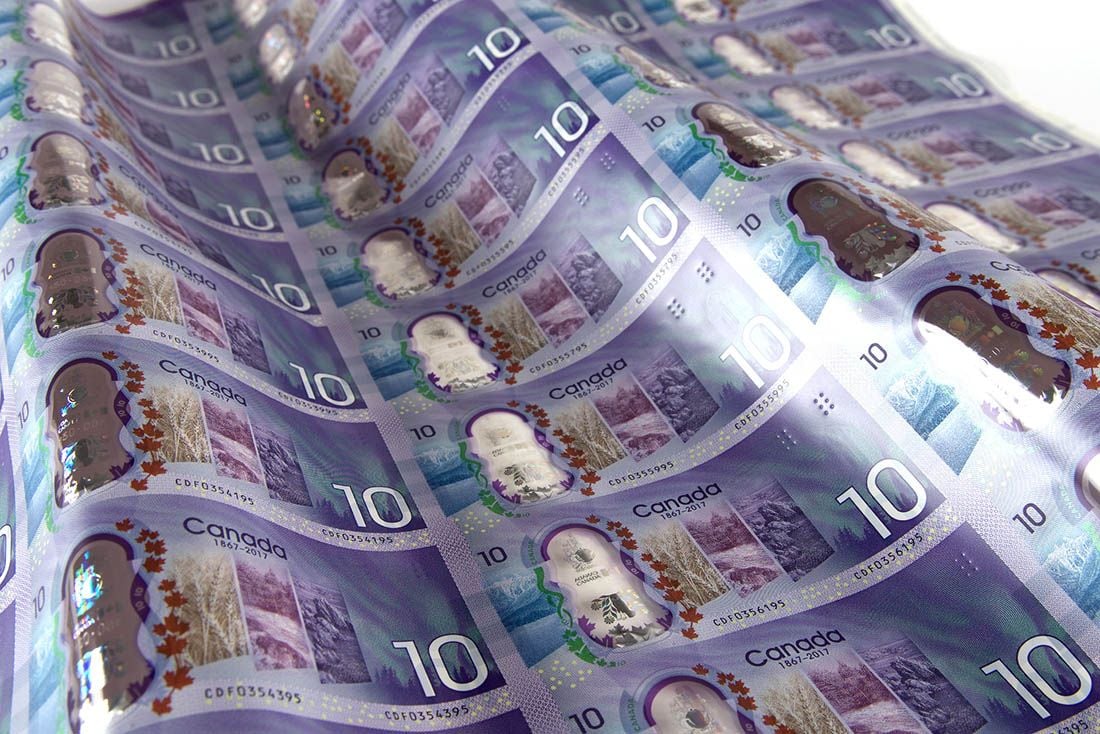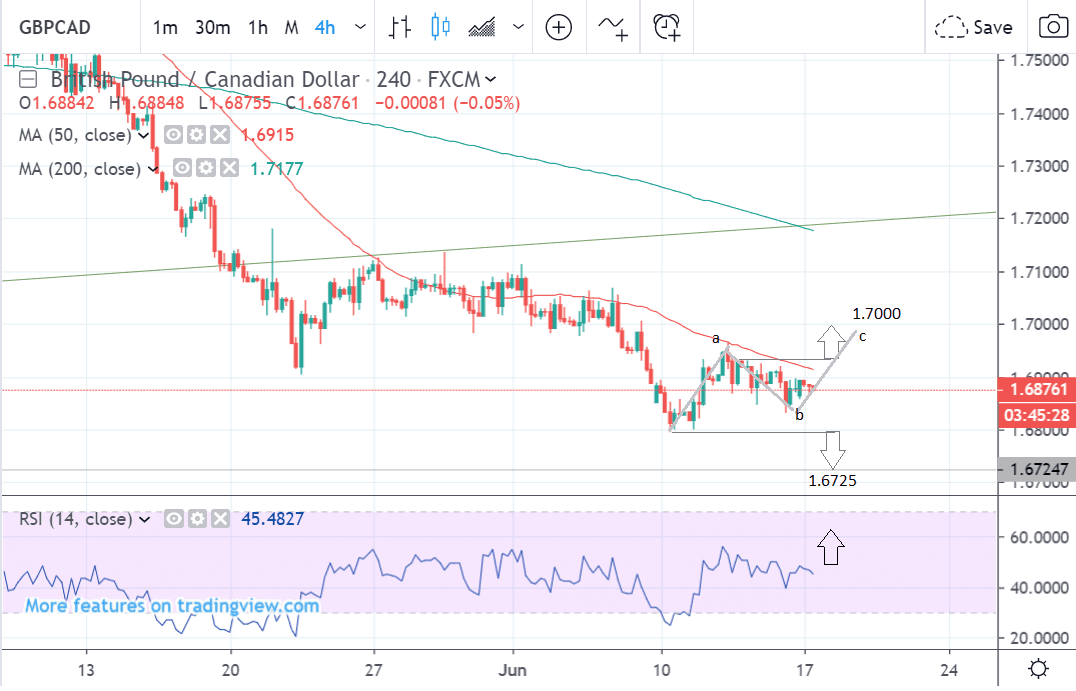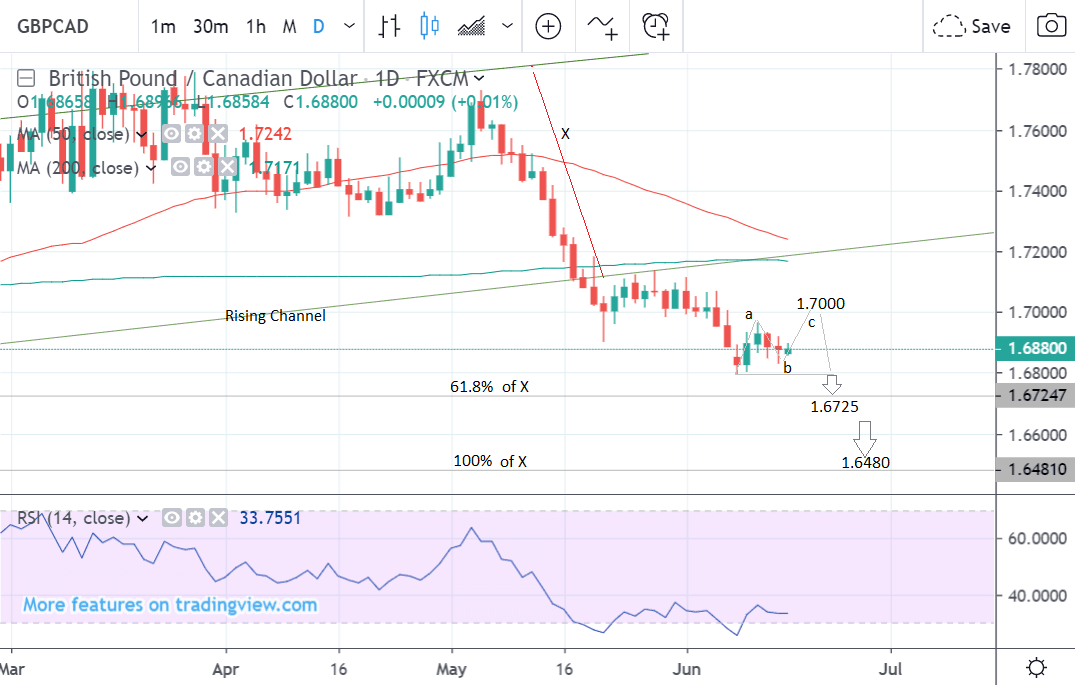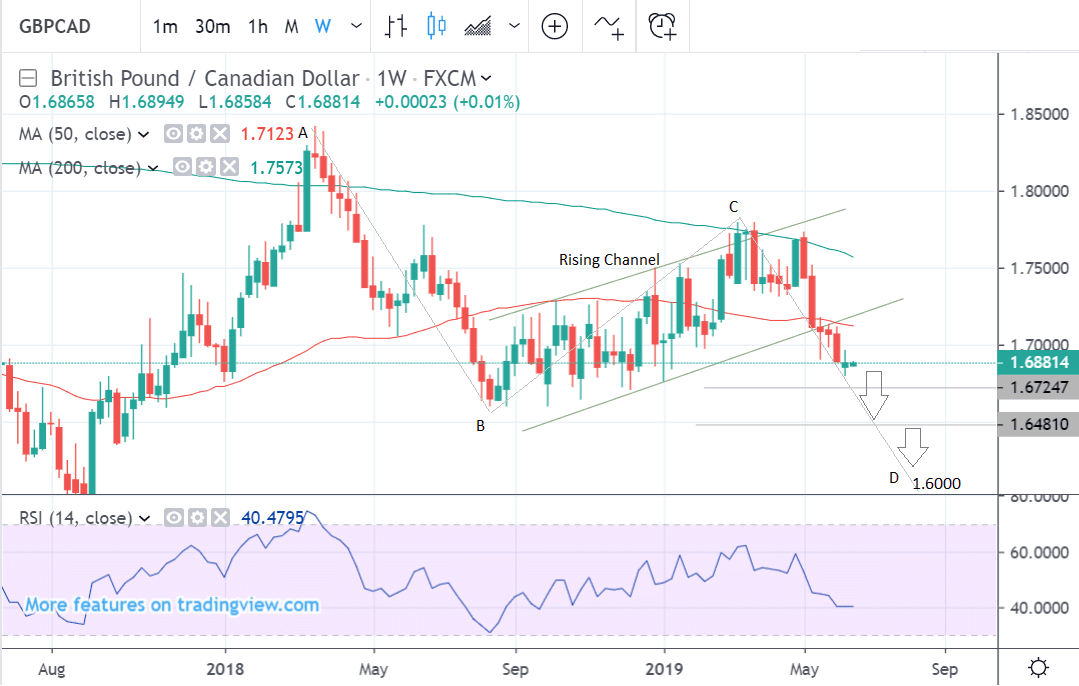Pound-to-Canadian Dollar Rate Week Ahead Forecast: Chance for Gains Short-Term, Broader Trend Still Negative

Image © Bank of Canada
- GBP/CAD mixed in short-term and could pop higher
- More downside expected in medium and long-term
- Pound to be impacted by Conservative leadership contest
- Canadian Dollar subject to economic data
The Pound-to-Canadian Dollar rate is trading at 1.6789 at the start of the new week, having notched up a gain of about 0.40% in the previous week. On a month-on-month basis the exchange rate is however 1.0% lower and studies of the charts are showing a mixed outlook.
The 4-hour chart - which is used to determine the short-term outlook including the coming week - shows the pair could have found a floor at the June 10 lows and be correcting higher, which gives us an expectation for potentially benign price action over coming days.
The correction looks like an incomplete three wave ABC correction, or zig-zag correction, with wave C still yet to unfold.
There is a chance it could unfold and reach 1.7000 eventually. A break above 1.6940 would provide confirmation.
The patterning of the RSI (a momentum indicator, highlighted in purple in the above) also looks poised to break higher reinforcing the possibility of more upside in the short-term as momentum turns positive.
Yet at the same time, either after the completion of the ABC or earlier there is also a possibility the pair could continue declining in line with the broader downtrend.
A break below the 1.6795 June 10 lows would provide confirmation of more downside down to a target at 1.6725.
The daily chart shows how the pair has broken out of a rising channel and is bearishly inclined over the medium-term, defined as between a week to a month, which is the period of time the daily chart is used for analysis purposes.
The height of the channel - ‘X’ - can be used to gauge follow-through lower. Prices will normally fall 61.8% or 100.0% of the height. This indicates a strong possibility of a continuation down to a target at either 1.6725 or possibly even 1.6480, over the medium term.
The weekly chart - which is used to analyse the long-term trend over the next few months - is showing the possibility of a bearish continuation down to a potential downside target at 1.6000 in the long-term.
The pair may have formed an ABCD Gartley pattern since rolling over at the March highs. If so, the final C-D leg is probably currently unfolding and will lead to an extension down to an even lower downside target in the following months.
Time to move your money? Get 3-5% more currency than your bank would offer by using the services of foreign exchange specialists at RationalFX. A specialist broker can deliver you an exchange rate closer to the real market rate, thereby saving you substantial quantities of currency. Find out more here.
* Advertisement
The Canadian Dollar: What to Watch
The major domestic data releases on the horizon for the Canadian Dollar are probably inflation and retail sales data; whilst on the macro front, the price of oil could also impact, since crude is one of Canada’s leading foreign exchange earners.
The Canadian economy is doing relatively well compared to its peers and the Bank of Canada (BOC) is not expected to cut interest rates, unlike the U.S Federal Reserve which is expected to cut interest rates at least twice in 2019.
“At least two rate cuts are priced in for the U.S. Federal Reserve, the bar remains high for a rate cut in Canada. Absent a realisation of downside risks, don’t bet on a rate cut by the Bank of Canada this year,” says Canadian investment bank TD Securities.
Inflation data is expected to be robust, therefore, in a reflection of the BOC’s neutral stance, when it is released on Wednesday, June 19, at 13.30 BST.
Current forecasts are for broad CPI to rise 0.2% on a monthly basis in May compared to 0.4% in April.
A higher-than-expected figure would benefit the Loonie and vice versa for a lower figure since higher inflation would increase pressure on the BOC to raise interest rates, and these drive up net foreign capital inflows, which supports the currency. The opposite is true for lower interest rates.
Core inflation, which excludes volatile food and fuel components, is forecast to rise 1.2% in May on a yearly basis from 1.5% previously.
“The Canadian dollar finally managed to halt its year-to-date slide against the greenback in June as US data disappointed, while Canadian indicators fared much better in comparison,” says Raffi Boyadijian, an economist at broker XM.com. “Next week’s releases could further help shift sentiment for the loonie as May inflation figures are due on Wednesday and April retail sales follow on Friday.”
Retail sales are forecast to show a 0.2% rise in April when they are released at 13.30 on Friday.
Given consumers are the main driving factor in growth, which is highly correlated to FX strength, a better-than-expected result would support the Canadian Dollar.
Oil prices have stopped falling at $52.00 per barrel for WTI and $40.00 for Canada Select. Two attacks on oil tankers in the gulf were the fundamental drivers as they raised fears about disruptions to global supply.
It is a positive factor that the decline in oil appears to have plateaued, although until there are signs or a trend reversal the Loonie is unlikely to gain any benefit from oil price dynamics.
The Pound: Boris 'in the Price'

Brexit politics is still likely to have the greatest impact on Sterling, with the Bank of England (BOE) rate meeting, CPI and retail sales data also likely factors driving the exchange rate.
The race to become the next Conservative leader and Prime Minister will continue next week with the vote to decide who goes through to the next round late on Tuesday, June 18. This time the seven remaining contestants will need at least 32 votes to get through to the next round.
More rounds of voting are expected on Wednesday and Thursday at which MPs will finally whittle the contest down to just two remaining candidates.
These will then be put to a vote amongst the wider Conservative party membership.
The first round of voting amongst conservative MPs resulted in a clear win for Boris Johnson, who gained 114 votes - significantly more than his nearest rival Jeremy Hunt, who came second with 43. Michael Gove was third with 37.
It is widely expected that Boris Johnson will win the wider vote amongst Conservative members. It seems highly likely, therefore, he will be the next Prime Minister.
Markets are more-or-less accustomed to this outcome by now, and we therefore wonder if this outcome is already 'in the price' of Sterling: i.e. it is not a Johnson win that will move Sterling, instead we believe it is what he says about his intentions on Brexit that will most likely matter going forward.
We know Johnson favours a renegotiated deal with the EU, and a 'no deal' Brexit is not his preferred outcome on October 31.
However, if the EU are unwilling to renegotiate he has indicated that he will pursue a 'no deal' Brexit.
Therefore a Johnson win is not necessarily bad for Sterling, instead the key issue going forward will be how the EU reacts to his advances for a renegotiation, and his subsequent response.
As such, be wary of a potential recovery in Sterling over coming days as there is a chance market's pare back on their expectations for a 'no deal' Brexit.
"BoJo is likely the new PM in UK once the dust settles after all the balloting over the next few weeks. The thing that we look forward to the most, is when BoJo takes May’s deal to the commons again, just with a new name. We would by the way prefer to buy GBP, once Boris is confirmed as the PM – buy the rumour, sell the fact (in EUR/GBP)," says Andreas Steno Larsen, an analyst with Nordea Markets.
Bank of England Meeting Could Prove Supportive
Another key driver of the Pound is the Bank of England (BOE) policy meeting on Thursday, June 20 at 12.45 BST. Although it is not accompanied by a press conference the minutes published after the meeting may contain important information which could drive Sterling.
The BOE has adopted a hawkish stance of late - hawkish meaning in favour of higher interest rates - owing to the country's solid Labour market. Higher interest rates would be positive for Sterling as they attract higher net inflows of foreign capital.
“Despite the growth worries, however, and the rising risks of a no-deal Brexit, the BoE is sticking to its central projection that some tightening in monetary policy will be needed over the next 2-3 years,” says Raffi Boyadijian, an economist at XM.com. “With no press conference or quarterly forecasts scheduled for the June meeting, the BoE is widely anticipated to repeat the same message in its statement.”
There are two risks: 1) that the Bank strikes a more cautious tone due to slowing global growth, largely resulting from U.S.-China trade tensions. This could send Sterling lower. However, we note the UK is less exposed to global trade dynamics than other economies, such as the Eurozone. Therefore, this risk might not come to pass.
Or, 2) the Bank strikes a more optimistic tone owing to the ongoing strength of the labour market that continues to generate increasing wages. This in turn threatens higher rates of inflation in the future. If the Bank notes this, the Pound could find support, or go higher.
CPI and Retail Sales
As mentioned, inflation is a key concern for the Bank of England, and by extension Sterling. The outcome of Wednesday's inflation numbers could therefore be important.
UK inflation data is expected to show a slower 0.3% and 2.0% rise on a monthly and yearly basis in May, from 0.6% and 2.1% in April, when data is released on Wednesday at 9.30 BST.
A higher-than-expected result might impact mildly on the Pound as it increases the chances of the BOE raising interest rates.
Retail sales are forecast to show a -0.5% and 2.7% change on a monthly and yearly basis in May, compared to the previous 0.0% and 5.2% changes respectively, in April, as the economy continues cooling.
A lower-than-expected result might impact negatively on the Pound as it would suggest the slowdown was more acute. Lower sales suggest a slowdown in GDP since consumers are the main driver of the economy.
Time to move your money? Get 3-5% more currency than your bank would offer by using the services of foreign exchange specialists at RationalFX. A specialist broker can deliver you an exchange rate closer to the real market rate, thereby saving you substantial quantities of currency. Find out more here.
* Advertisement







